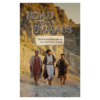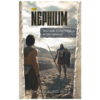Regardless of religious background, most people would admit that if supernatural events occurred at the crucifixion of Christ and if He actually rose from the grave, it would be the most significant event in history. Christ’s impact on history is profound—we even divide all of known history by His existence. Did something amazing happen at Christ’s crucifixion that led to the rapid expansion of Christianity around the Middle East, then quickly around the globe? Let’s take a look at what the Bible says about the supernatural events that occurred at Christ’s death:
“Now from the sixth hour until the ninth hour there was darkness over all the land. And about the ninth hour Jesus cried out with a loud voice, saying, ‘My God, My God, why have You forsaken Me?’… And Jesus cried out again with a loud voice, and yielded up His spirit. Then, behold, the veil of the temple was torn in two from top to bottom; and the earth quaked, and the rocks were split, and the graves were opened; and many bodies of the saints who had fallen asleep were raised; and coming out of the graves after His resurrection, they went into the holy city and appeared to many. So when the centurion and those with him, who were guarding Jesus, saw the earthquake and the things that had happened, they feared greatly, saying, ‘Truly this was the Son of God!’”[1]
This passage includes five events that can be evaluated historically: (1) darkness covering the land for three hours, (2) the temple veil tearing in half, (3) a significant earthquake, (4) many graves opening and the dead coming back to life, and (5) a Roman Centurion and his soldiers having on-the-spot conversions after seeing the miraculous events at his death.
Let’s take a look at the first one: the three hours of darkness that occurred during the crucifixion which was recorded by three of the Gospel writers. The accounts given by Matthew and Mark were very similar and Luke, the physician, wrote: “It was now about the 6th hour, and darkness came over all the land until the 9th hour, the sun failing.” Note that all three writers testify that the darkness lasted for three hours, and that it “covered all the land.”
Was this a natural event, or a supernatural one? Actually, we believe it was a supernatural event because natural events that cause darkness—like storms and eclipses—just don’t fit the historical descriptions of what happened. While storms can create temporary darkness, they don’t cause the sun to “fail” and none of the historical descriptions of this event—biblical or secular—mention a storm or even rain. Eclipses can also cause darkness, but only for minutes—not for three full hours—and history is clear that Jesus was crucified on Friday the 14th of Nisan during the Jewish Passover, and Passovers only occur on full moons, making an eclipse impossible because the moon was on the far side of Earth away from the Sun.
Before looking into the historical support for this event, let’s first answer the question, “Why is it even important”? At the crucifixion, God the Father placed all the sins of mankind (including yours and mine) upon His Son Jesus Christ, and God poured out His wrath upon Him. Jesus stood in our place and bore the punishment we deserved. Jesus cried out in a loud voice, “My God, my God, Why have you forsaken me?” Jesus was separated from his Father for three hours. God signified this by blotting out the sun until Jesus had the paid the price for sin in full. So the sun being covered in darkness represented what was happening to the Son as He was covered by the darkness of our sin and judgement.
But is there any historical evidence to verify that the three hours of darkness really happened? Actually there is! We’ll quickly review just some of the highlights from dozens of ancient historians who documented this event, and we’ll use both Christian and non-religious sources. We’ve already reviewed the writings from three biblical authors who recorded them shortly after Christ’s crucifixion. Then, for centuries afterwards, historians continued to write about this supernatural event in ways that were remarkably consistent. Let’s review just some of these.
Outside of the Bible, the oldest account was written by a historian named Thallus in A.D. 52. Scholars believe that Thallus recorded the event in a way that minimized the supernatural, trying to explain it as just a natural eclipse. Though we no longer have Thallus’ original writings, we have the quotations from his works made by later writers such as Julius Africanus, a leader in the Roman empire who was instrumental in setting up the public library in the Pantheon at Rome. Julius wrote the five-volume set titled the History of the World in about A.D. 221. In this work, Julius wrote: “Thallus, in his third book of histories, explains away the three hours of darkness as an eclipse of the sun—unreasonably as it seems to me. For the Hebrews celebrate the Passover on the 14th day according to the moon, and the passion of our Savior falls on the day before the Passover; but an eclipse of the sun takes place only when the moon comes under the sun. And it cannot happen at any other time but in the interval between the first day of the new moon and the last of the old, that is, at their junction: how then should an eclipse occur when the moon is almost diametrically opposite the sun?”
The writing of Thallus shows that the facts of Jesus’ death were known and discussed in Rome as early as the middle of the first century, to the extent that unbelievers like himself thought it necessary to explain the matter of the darkness as a natural event like an eclipse. But Thallus did not question the historicity of Jesus, nor the three hours of darkness that occurred at his death. Rather, he affirmed it!
At the time of his writing, anti-Christians had already been explaining the period of darkness as only a natural phenomenon, such as an eclipse. Origen, for example, had written that this idea of it being an eclipse was an invention of the pagans to discredit the Gospels.
Phlegon of Tralles, a first century Greek historian born not long after the crucifixion, wrote one of the most well-known books of ancient history titled, “OLYMPIADES.” Phlegon wrote: “In the 4th year of the 202nd Olympiad, there was a great eclipse of the Sun, greater than had ever been known before, for at the 6th hour the day was changed into night and the stars were seen in the heavens. An earthquake occurred in Bythinia and overthrew a great part of the city of Nicaea.”[2]
Phlegon’s account reveals several key things. The sun was darkened during Christ’s death along with a great earthquake. The time of the darkness agrees with Matthew 27. His entry also gives us the year of the crucifixion, with the 202nd Olympiad running from July A.D. 29 to June A.D. 33. Also, several of the early church Fathers quoted him, so there seems no reason to doubt his word.
Another historian, Philipon, confirms the historicity of Phlegon’s statement by writing: “And about this darkness—Phlegon recalls it in the Olympiads… he mentioned the eclipse which took place during the crucifixion of the Lord Christ, and no other (eclipse), it is clear that he did not know from his sources about any (similar) eclipse in previous times… and this is shown by the historical account of Tiberius Caesar.”[3]
Another well-known historian, Origen, when responding to Celsus, a critic of the supernatural elements in the Gospels, wrote: “With regard to the eclipse in the time of Tiberius Caesar, in whose reign Jesus appears to have been crucified, and the great earthquakes which then took place, Phlegon too I think has written in the 13th or 14th book of his Chronicles” and “Celsus imagines also that both the earthquake and the darkness were an invention, but regarding these, we have in the preceding pages made our defense, according to our ability, adducing the testimony of Phlegon, who relates that these events took place at the time when our Savior suffered.”
Julius Africanus even wrote: “Phlegon records that in the time of Tiberius Caesar, at full moon, there was a full eclipse of the sun from the 6th hour to the 9th, manifestly that one of which we speak.” Additional writers who refer to Phlegon’s account of the darkness include Joannes Philoponus, Malelas, Origen, Eusebius, and Maximus. Together, this makes seven ancient writers who directly quote Phlegon, qualifying this fragment as one of the best-attested ancient writings.
Fourth century records from the early church fathers include the Letter of Pontius Pilate which He wrote to the Roman Emperor concerning Christ. Well-known historian Justin Martyr even referred to these records. Pilate’s letter stated, “And at the time he was crucified there was darkness over all the world, the sun being darkened at mid-day, and the stars appearing, but in them there appeared no luster; and the moon, as if turned into blood, failed in her light… And in that terror dead men were seen that had risen, as the Jews themselves testified … And the fear of the earthquake remained from the sixth hour of the preparation until the ninth hour.”[4]
Tertullian, a Juris Consult familiar with the Roman archives, wrote in A.D. 197: “At that same moment about noontide, the day was withdrawn; and they, who knew not that this was foretold concerning Christ, thought it was an eclipse. But this you have in your archives; you can read it there.” He continues: “Yet nailed upon the cross, Christ exhibited many notable signs, by which His death was distinguished from all others. At His own free-will, He with a word dismissed from Him His spirit, anticipating the executioners work. In the same hour, too, the light of day was withdrawn, when the sun at the very time was in his meridian blaze. Those who were not aware that this had been predicted about Christ, no doubt thought it an eclipse.”
Writing about the year A.D. 315, Eusebius, who was a historian of the Emperor Constantine, wrote: “Jesus Christ underwent his Passion in the 18th year of Tiberius [AD 33]. Also at that time in another Greek compendium we find an event recorded in these words: ‘the sun was eclipsed, Bithynia was struck by an earthquake, and in the city of Nicaea many buildings fell.’”
The accounts of the darkness that occurred at Christ’s crucifixion continued even into the 6th century AD. The historian Cassiodorus wrote: “Our Lord Jesus Christ suffered… and an eclipse (the literal translation is a “failure” or “desertion”) of the sun occurred, such as never was before or since.”
Isn’t it amazing that so many references exist that testify to such an unusual event? Next we’ll take a look at the second of the five events that the Bible says occurred at the crucifixion of Christ: the temple veil tearing in half.
Matthew states, “Jesus, again crying out in a loud voice, yielded up his spirit. At that moment the curtain in the Temple was ripped in two from top to bottom; and there was an earthquake with rocks splitting apart.” The curtain referred to comes from the Aramaic word parokhet, which was a one-foot thick piece of fabric covering the entrance to the holy of the holies in the Second Temple. The veil of the temple had always shown to the people how approaching a holy God was difficult for sinful man. The only way a sinful man could approach God was through the high priest who would enter into the holy of holies through the veil of the temple, only after making many sacrifices. The idea was that God cannot be approached by sinful man, lest he be destroyed. That all changed when Christ, who was the perfect sacrifice, gave us access to God at the very moment he died.
So how do we know this actually happened? Recent archeological discoveries reveal that the Temple in Jerusalem during King Herod’s reign did in fact have a huge, east-facing curtain—a veil—that was suspended on the eastern lintel in front of metal doors marking the entry of the Holy Place. The A.D. 33 earthquake evidently displaced the Temple’s lintel, tore the curtain, and shifted the pivots for the metal doors.
Next we have the earthquake. We’ve already covered many of the historical accounts that attest to both the darkness and the earthquake at Christ’s crucifixion. These include: Phlegon of Tralles who said an earthquake occurred in Bythinia and overthrew a great part of the city of Nicaea, as well as certain places in Italy; Origen who noted “the great earthquakes” which took place during the crucifixion; Pontius Pilate who said, “the fear of the earthquake remained from the sixth hour of the preparation until the ninth hour;” and of course Matthew’s account, which even many secular historians consider valid. Even Pliny the Elder wrote an account of an earthquake occuring in the surrounding regions at that time.
We don’t have to do much research to find out there was an earthquake when Christ died. Even the federal agency “National Centers for Environmental Information”[5] documents this. Recent documentaries such as the “Christ Quake”[6] and the “Crucifixion Quake”[7] have well substantiated the evidence for the earthquake that happened when Christ died. Stunning evidence based on the varves and seismites in the dead sea layers confirm the Crucifixion earthquake. These studies have even been reported in mainstream media outlets like NBC News and others.[8] Renown geologist Dr. Steve Austin’s work on this topic has been published around the world.[9]
Next we have the graves opening and numerous people being raised from the dead after Christ’s resurrection.[10] Matthew recorded: “The graves were opened; and many bodies of the saints who had fallen asleep were raised; and coming out of the graves after His resurrection, they went into the holy city and appeared to many.” If this really happened, it certainly would have set Christ’s death apart from any other in history, and it would have created quite a stir among the people of that time.
The apostolic Father Ignatius records the earliest commentary we have on this event, and his works have been widely trusted throughout church history. Ignatius wrote to the Trallians: “For says the Scripture, ‘Many bodies of the saints that slept arose,’ their graves being opened. He descended, indeed, into Hades alone, but He arose accompanied by a multitude.”[11] He also acknowledged this event in a letter to the Magnesians between AD 70 and 115.
Irenaeus, who personally knew Polycarp who was a disciple of the apostle John wrote: “Christ suffered who can lead those souls aloft that followed His ascension. This event was also an indication of the fact that when the holy hour of Christ descended to Hades, many souls ascended and were seen in their bodies.”
Another second century Father, Clement of Alexandria, verified the resurrection of the saints in Matthew 27 by writing, “But those who had fallen asleep descended dead, but ascended alive. Further, the Gospel says, ‘that many bodies of those that slept arose,’—plainly as having been translated to a better state.”
The Father of Latin Christianity, Tertullian, wrote: “And the sun grew dark at mid-day; and when did it ‘shudder exceedingly’ except at the passion of Christ, when the earth trembled to her center, and the veil of the temple was rent, and the tombs burst asunder?”
Early church Fathers in the East also verified the historicity of Matthew’s account. Cyril of Jerusalem wrote: “But it is impossible, someone will say, that the dead should rise; and yet Elisha twice raised the dead, when he was live and also when dead…and is Christ not risen? … But in this case both the Dead of whom we speak Himself arose, and many dead were raised without having even touched Him. For many bodies of the Saints which slept arose, and they came out of the graves after His Resurrection, and went into the Holy City, evidently this city in which we now are, and appeared to many.”
Finally we have the letter of Pontius Pilate to the Roman Emperor where he mentioned than people were terrified, having seen dead men risen, as even testified by the Jews.[12]
Many other biblical and secular scholars confirmed this resurrection event, including Hilary of Poitiers, Chrysostom, and even Saint Augustine, Saint Remigius, Thomas Aquinas, and John Calvin.
Finally we have the Centurion and those with him who witnessed the earthquake and other events, who “feared greatly” and proclaimed: “Truly this was the Son of God!” What type of events would it take to persuade a battle-hardened Roman Centurion in charge of an execution come to great fear and acknowledge that Christ was the son of God? Think about it—here is a guy in charge of 80 soldiers that is moved to such fear that he admits—right in front of his subordinates—that they very person they are trying to execute is the son of God. There must have been extremely out-of-the-ordinary things going on for this to happen.
So there we have it: the darkness, temple veil, earthquake, dead people rising from their graves, and the same-day conversion of a Roman Centurion and his soldiers. These events were followed by Christ’s resurrection and 2,000 years of changed history. This evidence all mounts to a conclusion that leads to the obvious, miraculous conclusion!
Sources:
[1] Matthew 27:45-46 ,50-54.
[2] https://www.textexcavation.com/phlegontestimonium.html: In the fourth year, however, of Olympiad 202, an eclipse of the sun happened, greater and more excellent than any that had happened before it; at the sixth hour, day turned into dark night, so that the stars were seen in the sky, and an earthquake in Bithynia toppled many buildings of the city of Nicaea. These things [are according to] the aforementioned man.
[3] Mark E Jeffries, “The Coming Of The Messiah” (November 14, 2011) (lulu press).
[4] From the Acts of Pilate, First Greek Form (as extant, not older than 4th century AD, but a work of this name, the Acts of Pontius Pilate, is referred to by Justin Martyr, I Apol. 35, 48, in the middle of the 2nd century AD, in his defense before the Emperor, who would have been able to examine these Acts himself, so this may be a reworking of earlier, genuine material. See also:
https://www.oxfordbiblechurch.co.uk/index.php/teachings/bible-chronology/2569-the-day-the-sun-stopped-shining-full-version
https://archive.org/details/AnteNiceneChristianLibraryV16/page/n261/mode/2up
Ante-Nicene Christian Library; Translations Of The Writings Of The Fathers Down To A.D. 325, Volume 16: Apocryphal Gospels, Acts, And Revelations by Roberts, Alexander, 1826-1901 ed; Donaldson, James, Sir, 1831-1915 (ed). Available: https://archive.org/details/AnteNiceneChristianLibraryV16/page/n255/mode/2up?q=ninth. See also here: “Ante-Nicene Christian Library: Translations of the Writings of the Fathers Down to A.D. 325″ (p. 226) (https://archive.org/stream/antenicenechris19donagoog/antenicenechris19donagoog_djvu.txt). See also the translation of the letter of Pilate to Claudius, found in the Acts of Peter and Paul; also a similar letter incorporated in The Gospel of Nicodemus, second part, Latin, first version, chap. 13 (29).
[5] https://ngdc.noaa.gov/nndc/struts/results?eq_0=8178&t=101650&s=13&d=22,26,13,12&nd=display and see: Alsinawi, S.A., S.G. Baban, and A.S. Issa; 1985; Historical seismicity of the Arab region. IASPEI/UNESCO Working Group on Historical Seismograms and Earthquakes, August 27-28, 1985, Tokyo; Preliminary Proceedings, p. 59-84.
[6] https://christquake.com/
[7] https://www.imdb.com/title/tt9475622/
[8] See p. 308 of Migowski (Migowski, C., et al. (2004). “Recurrence pattern of Holocene earthquakes along the Dead Sea transform revealed by varve-counting and Radiocarbon dating of lacustrine sediments.” Earth and Planetary Science Letters 222(1): 301-314.); and p. 13 From Kagan et al: and by laminae‐counting of ∼1500 years, from 200 B.C. to 1300 A.D. [Migowski, 2001; Migowski et al., 2004]. The laminae‐counted floating chronology of the seismites was matched with the historic earthquake catalog. The best‐fit history of Migowski et al. [2004] gave ages younger than their radiocarbon ages by 50–200 years, consistent with reworking of organic debris (e.g., wood) in the nearshore environment before settling to the bottom of the dense saline lake. In our analysis, the chronologies of the Ze’elim and Ein Feshkha section indicate no long reworking time of the organic debris before settling in the sediment. When referring to the seismites from the Ein Gedi (EG) core only we use the shifted laminae‐counted chronology of Migowski et al. [2004] for the EG section. Also see page 20: Ben‐Menahem [1991]; AR, Amiran et al. [1994]; WL, Willis [1928]. AM3, Ambraseys [2009]; In the first column, (1) and (2) designate separate earthquakes within the same time period. References: AJ, Ambraseys and Jackson [1998]; AK, Ambraseys and Karcz [1992]; AM1, Ambraseys et al. [1994]; AM2, Ambraseys [1962]; AV, Avni [1999]; BM, DV, Dever [1992]; GB1, Guidoboni et al. [1994]; GB2, Guidoboni and Comastri [2005]; KZ1, Karcz and Kafri [1978]; KZ2, Karcz [2004]; NE, Neev and Emeery [1995]; NR, Nur and Ron [1997]; RU1, Russell [1980]; RU2, Russell [1985]; SB, Sbeinati et al. [2005]; SC, Schaeffer [1948]; WL (after Arvanitakis) documents damage to Jerusalem, Judea, Bithynie (Anatolia). New Testament (St. Matthew) mentions earthquake during time of the crucifixion.
[9]https://www.nbcnews.com/id/47555983/ns/technology_and_science-science/t/quake-reveals-day-jesus-crucifixion-researchers-believe/#.WavujdFlCf0 See also: Williams, Jefferson, Schwab, Markus, Brauer, Achim An early first-century earthquake in the Dead Sea, International Geology Review 54, 1219–1228 (2012/07/01).
https://www.elperfecto.com/2013/12/12/earth-quaked-in-33-ad-when-jesus-was-crucified/
[10] https://normangeisler.com/the-early-fathers-and-the-resurrection-of-the-saints-in-matthew-27/; https://www.truthortradition.com/articles/what-about-matthew-2752-and-53; https://lf-oll.s3.amazonaws.com/titles/1975/1333.08_Bk.pdf; https://www.scribd.com/document/7239411/Letter-From-Pontius-Pilate-to-Tiberius-on-Jesus; https://www.youtube.com/watch?v=oD9FRnJdyb0; https://normangeisler.com/the-early-fathers-and-the-resurrection-of-the-saints-in-matthew-27/
[11] Ignatius of Antioch (Early 2nd Century, writings c.105AD – c.115AD). ‘Letter to the Trallians’, Chapter IX.
[12] The ACTS of PILATE: A work of this name is referred to by Justin Martyr, 150 AD.








